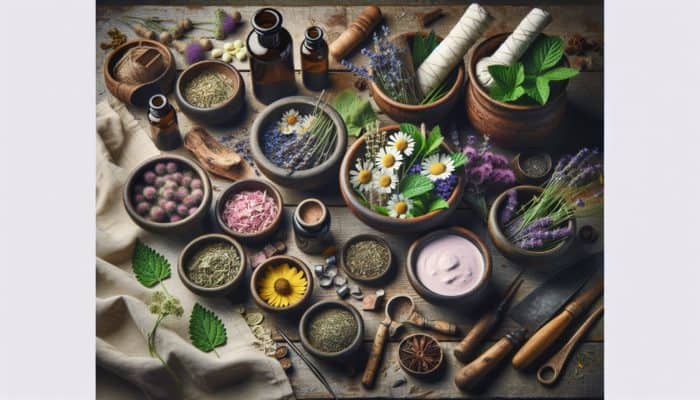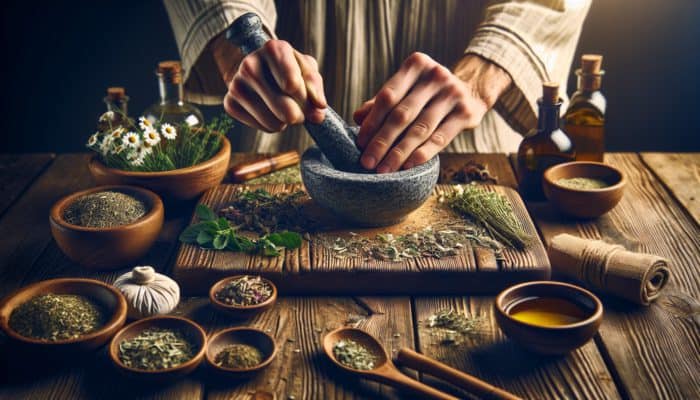Discover the Incredible Health Advantages of Ashwagandha
What Is Ashwagandha and Why Is It Vital for Your Overall Wellness?

The extraordinary herb known as Ashwagandha, scientifically identified as Withania somnifera, has a storied past in traditional medicine and occupies a crucial position in Ayurveda, the ancient Indian holistic healing framework. Esteemed as a potent adaptogen, ashwagandha equips the body to adeptly handle stress, thus fostering overall health and wellness. This remarkable herb has attracted global attention due to its vast array of health benefits, which include stress relief, cognitive enhancement, and improved physical performance. The adaptogenic characteristics of ashwagandha bolster the body’s resilience against both physical and emotional challenges, establishing it as an invaluable component of wellness strategies across the globe.
In our rapidly evolving society, the increasing demand for natural health solutions, such as ashwagandha, has become unmistakably clear. Individuals from diverse backgrounds are acknowledging the crucial importance of effective stress management in improving their overall health and quality of life. By fine-tuning physiological responses, ashwagandha paves the way for promising advancements in well-being, making it especially appealing to those who seek holistic health options that resonate with their lifestyles and values.
The Rich Legacy of Ashwagandha in Traditional Healing Systems
The use of ashwagandha boasts a historical lineage that reaches back thousands of years, with its roots firmly planted in ancient Ayurvedic texts. Over the centuries, this powerful herb has emerged as an essential tool for boosting vitality, enhancing stamina, and promoting longevity among its users. Cultures from India to the Middle East have held ashwagandha in high regard for its remarkable potential to rejuvenate both body and mind, often viewing it as a cornerstone of their healing traditions.
Historical documentation reveals that healers utilized ashwagandha to tackle a multitude of health concerns, particularly those associated with stress and fatigue. Its enduring reputation as a robust restorative herb has transcended geographical barriers, impacting modern herbal practices worldwide. As contemporary scientific investigations increasingly validate these time-honored beliefs, the historical importance of ashwagandha deepens in present-day health discussions.
How Is Ashwagandha Gaining Recognition in Contemporary Medical Fields?
In recent times, ashwagandha has established itself as a significant player in modern medicine. Researchers have undertaken extensive studies to explore its numerous benefits, such as its ability to alleviate stress levels, boost testosterone production, and enhance cognitive function. Scientific evidence consistently corroborates these advantages, generating heightened interest among healthcare professionals and consumers alike.
The adaptogenic properties of ashwagandha have particularly captivated those in search of natural alternatives to traditional stress-relief methods. As awareness grows regarding the adverse effects linked to synthetic medications, many individuals are gravitating toward natural supplements like ashwagandha. Consequently, the global health community is beginning to accept the herb’s potential, leading to its incorporation into various health products aimed at enhancing mental clarity and physical performance.
How Does Ashwagandha Support Mental Health and Emotional Well-Being?

Ashwagandha is increasingly acknowledged for its significant influence on mental health. Clinical research has substantiated its efficacy in alleviating symptoms of anxiety and depression, positioning it as a promising resource for improving overall emotional wellness. Additionally, its capacity to enhance sleep quality further bolsters mental health by fostering recovery and resilience.
The herb’s function in regulating cortisol levels—a hormone closely linked to stress—has been the focus of numerous studies. By normalizing cortisol levels, ashwagandha promotes a sense of tranquility and emotional stability, which is crucial for navigating the stresses of everyday life. As mental health issues become more prevalent globally, ashwagandha emerges as a natural, accessible solution that aligns with the growing trend toward holistic health approaches.
How Can You Easily Add Ashwagandha to Your Daily Routine?
Incorporating ashwagandha into your daily regimen can be both straightforward and enjoyable. The herb is available in various forms, including capsules, powders, and teas, allowing individuals to choose an option that best aligns with their personal preferences and lifestyle. Consistency plays a vital role in achieving optimal results from ashwagandha, and adhering to recommended dosages is crucial for maximizing its benefits.
Many people find that starting their day with a nutritious smoothie containing ashwagandha powder is beneficial, while others may prefer taking capsules with their meals. Moreover, sipping ashwagandha tea can create a calming evening ritual that encourages relaxation and restful sleep. No matter which method you choose, integrating ashwagandha into your daily habits can lead to significant improvements in health and wellness.
Proven Techniques for Amplifying the Benefits of Ashwagandha
How Can You Effortlessly Include Ashwagandha in Your Daily Life?
Ashwagandha can be seamlessly incorporated into everyday routines through various practical applications. For instance, individuals might consider adding ashwagandha powder to their protein shakes, oatmeal, or even homemade baked goods, creating nutritious meals that leverage the herb’s beneficial properties. Alternatively, capsules provide a convenient option for those who prefer taking the supplement without altering their diet.
Some individuals enjoy preparing ashwagandha tea by mixing the powder with hot water, honey, and lemon to create a soothing beverage. A key factor in successfully using ashwagandha is consistency; regular consumption over time can yield more substantial health benefits. Many users report noticeable enhancements in their stress levels and overall well-being, highlighting the importance of maintaining a routine for optimal effects.
- Begin with a low dosage and gradually increase as necessary.
- Pair ashwagandha with meals to enhance nutrient absorption.
- Create enjoyable recipes that incorporate the powder.
- Keep track of your mood and energy levels to assess effectiveness.
What Are the Most Effective Ashwagandha Forms Available on the Market?
The market features a variety of ashwagandha products, each with distinct characteristics. The three most prevalent forms are capsules, powders, and liquid extracts. Capsules offer a straightforward option for those seeking convenience, while powders provide versatility, allowing for incorporation into various foods and beverages. Liquid extracts, being highly concentrated, may yield faster effects.
When selecting the ideal form of ashwagandha, it is important to consider bioavailability, which refers to the body’s ability to absorb and utilize the herb effectively. Powders often facilitate increased bioavailability, especially when paired with fats or other nutrients. Furthermore, the concentration of active compounds can differ across various forms, so consumers must carefully examine product labels to make informed decisions.
- Capsules: Convenient and easy to dose.
- Powders: Versatile for incorporation into various foods.
- Liquid extracts: Highly concentrated for rapid effects.
- Quality: Opt for products that undergo third-party testing.
What Are the Potential Side Effects Associated with Ashwagandha Use?
While ashwagandha is generally considered safe for most individuals, certain situations may lead to side effects. Some users have reported digestive issues, such as upset stomach or diarrhea, particularly at higher doses. Additionally, ashwagandha might cause drowsiness in some individuals, underscoring the importance of monitoring personal responses to the herb.
It is wise to consult with a healthcare provider before starting any new supplement regimen, especially for those with pre-existing conditions or individuals currently on medications. This precaution can help ensure safe and effective use while minimizing any potential adverse effects, allowing users to fully harness the health benefits of ashwagandha.
In-Depth Analysis of the Health Benefits of Ashwagandha
Why Is Ashwagandha Essential for Effective Stress and Anxiety Management?
Ashwagandha is widely acknowledged for its remarkable ability to significantly reduce stress and anxiety levels. Research indicates that it accomplishes this primarily by lowering cortisol, the body’s primary stress hormone. By regulating cortisol levels, ashwagandha fosters a deep sense of calm and emotional equilibrium, which is critical in today’s fast-paced world, where stress is omnipresent.
As an adaptogen, ashwagandha aids the body in adapting to various stressors. Regular consumption can lead to lasting improvements in resilience to stress. Users frequently report experiencing a more centered mindset, improved focus, and greater ease in managing life’s challenges. This positions ashwagandha as a crucial component of any effective stress management strategy, making it an invaluable resource for busy professionals or anyone looking to enhance their emotional health.
In What Ways Does Ashwagandha Boost Cognitive Function?
Research indicates that ashwagandha may significantly enhance cognitive function, encompassing aspects such as memory retention, focus, and overall mental clarity. Its neuroprotective properties could also shield the brain against degenerative conditions, making it an appealing option for individuals concerned about aging and cognitive decline.
By fostering neurogenesis and supporting synaptic function, ashwagandha creates an environment conducive to improved cognitive health. Users often experience sharper thinking, improved information retention, and enhanced problem-solving abilities. This advantage is especially beneficial in academic or high-pressure work environments where cognitive performance is crucial for success.
How Does Ashwagandha Contribute to Improved Physical Performance and Muscle Strength?
Ashwagandha has been linked to enhancements in physical performance and increased muscle strength, making it a popular choice among athletes and fitness enthusiasts. Numerous studies suggest that consistent supplementation can lead to increased muscle mass and strength, as well as reductions in body fat, especially when paired with regular exercise.
Its ability to boost energy levels and endurance empowers users to engage more fully in physical activities. Furthermore, ashwagandha’s role in alleviating post-exercise muscle soreness can facilitate quicker recovery times, which is essential for individuals adhering to rigorous training schedules. By incorporating ashwagandha into a fitness regimen, users may discover a natural edge in reaching their physical fitness aspirations.
Research-Backed Insights into the Advantages of Ashwagandha
What Does Scientific Research Say About Ashwagandha?
A wealth of scientific studies has explored the extensive benefits of ashwagandha. Research consistently demonstrates its effectiveness in reducing stress, enhancing cognitive function, and improving physical performance. Well-executed clinical trials validate its versatility across various contexts, affirming its relevance as a compelling field of ongoing research.
Notable findings from recent studies underscore the herb’s ability to effectively lower cortisol levels, enhance sleep quality, and improve overall mental well-being. These insights have established a foundational understanding of how ashwagandha can be integrated into broader health strategies, showcasing its potential as a widely applicable supplement in contemporary wellness practices.
- Effectively lowers cortisol levels.
- Enhances sleep quality and mental clarity.
- Improves athletic performance.
- Supports emotional well-being and alleviates anxiety.
How Does Ashwagandha Affect Hormonal Balance?
Ashwagandha has demonstrated its capability to influence hormonal balance, particularly by increasing testosterone levels in men and enhancing fertility in both men and women. This effect is facilitated through its support of the endocrine system, which governs hormone production and secretion.
By stimulating testosterone production, ashwagandha can boost libido, promote muscle growth, and improve overall vitality. For women, the fertility benefits include regulating menstrual cycles and enhancing reproductive health. The mechanisms underlying these advantages highlight ashwagandha’s role as a holistic health promoter, supporting individuals who wish to optimize their hormonal health naturally.
What Long-Term Benefits Can Be Gained from Consistent Ashwagandha Use?
Long-term use of ashwagandha may result in sustained improvements across various health domains, including stress management and cognitive function. Regular consumption contributes to cumulative benefits that can significantly enhance quality of life over time. Users frequently report sustained energy levels, sharper mental clarity, and an overall improved sense of well-being.
Establishing a long-term relationship with ashwagandha can provide individuals with a reliable strategy for maintaining health amidst modern stressors. As research continues to unfold regarding its effects, the potential for ashwagandha to become a staple in health regimens becomes increasingly apparent. Consistent use not only fosters personal health but also encourages a proactive approach to well-being.
How Can Ashwagandha Enhance Immune System Function?
Ashwagandha may improve immune function, enhancing the body’s capacity to fend off infections and illnesses. Research shows that it can increase white blood cell counts and boost antibody production, contributing to a more robust immune response. This aspect of ashwagandha’s profile is particularly significant in a time when safeguarding health is of utmost importance.
Regular consumption of ashwagandha can enhance overall health while fortifying the immune system’s resilience against various pathogens. Users often report experiencing a decrease in the frequency of colds and other common ailments, further emphasizing the herb’s role as a vital element of a comprehensive health strategy.
Practical Recommendations for Using Ashwagandha Effectively
How to Choose the Right Ashwagandha Supplement for Your Needs?
Selecting the ideal ashwagandha supplement necessitates thoughtful consideration of several critical factors. The form of ashwagandha—be it capsule, powder, or extract—should align with personal preferences and lifestyle choices. Additionally, consumers should assess the concentration of active ingredients, as these can vary considerably among different products.
Quality is essential; choosing supplements from reputable brands that are subjected to third-party testing can ensure safety and effectiveness. Researching product reviews and examining ingredient lists can also aid consumers in identifying high-quality options. A well-informed selection process can significantly enhance the overall experience and effectiveness of ashwagandha supplementation.
What Is the Recommended Daily Dosage for Optimal Ashwagandha Benefits?
The recommended dosage of ashwagandha can vary based on the formulation and individual health requirements. As a general guideline, for high-quality extracts, a daily dosage of 300-500mg is usually recommended for most adults. However, some individuals may require adjustments based on their specific health circumstances or objectives.
Starting with a lower dose and gradually increasing it allows users to evaluate their body’s response. Consulting with a healthcare provider can offer personalized recommendations tailored to specific health goals, ensuring the optimal use of ashwagandha for individual needs.
Innovative Ways to Incorporate Ashwagandha into Your Diet
Integrating ashwagandha into your diet can be both creative and advantageous. The powder can be easily blended into smoothies, yogurt, or oatmeal, enhancing nutritional value without significantly altering taste. For those who prefer alternatives, ashwagandha can also be mixed into herbal teas or even baked into healthy treats for an additional health boost.
Culinary enthusiasts can explore innovative recipes featuring ashwagandha, maximizing its benefits in delicious ways. Its versatility allows it to seamlessly fit into various culinary traditions, enabling diverse populations to incorporate it into their diets. The synergy of ashwagandha with other nutrient-dense ingredients can amplify both flavor and health benefits.
Future Directions in Ashwagandha Research and Applications
What Are the Latest Findings in Ashwagandha Research?
Current trends in ashwagandha research highlight the increasing interest in its potential applications beyond traditional uses. Ongoing studies are investigating its role in managing chronic diseases, enhancing mental health, and optimizing athletic performance. Researchers are exploring its mechanisms of action and long-term implications, aiming to solidify its place in contemporary wellness practices.
As scientific exploration advances, emerging evidence may reveal new benefits of ashwagandha, broadening its appeal across various demographics. The adaptability of this ancient herb fosters innovative applications in both clinical settings and wellness initiatives, paving the way for a more comprehensive understanding of its health-enhancing properties.
What Promises Does the Future Hold for Ashwagandha?
The future of ashwagandha looks bright, with expanding investigations into its health-enhancing capabilities. As the demand for natural health solutions continues to rise, ashwagandha stands at the forefront of herbal supplementation. Potential new applications in areas such as stress management, cognitive support, and fertility enhancement are currently under exploration.
Moreover, the potential integration of ashwagandha into functional foods and wellness products may encourage broader acceptance and utilization. As more individuals seek holistic health strategies, ashwagandha’s prominence is likely to grow, establishing it as a staple in numerous health-conscious households worldwide.
How Can Ashwagandha Continue to Improve Health Outcomes?
The adaptogenic properties of ashwagandha position it as a powerful ally in managing stress while promoting overall health. Its diverse benefits make it an attractive choice for those looking to naturally enhance their well-being. Ongoing research will further clarify its potential and highlight its significance in preventive healthcare.
As understanding of ashwagandha continues to expand, consumers will discover more opportunities to incorporate this potent herb into their health practices. Emphasizing its adaptability and effectiveness ensures that ashwagandha remains a central element of holistic wellness for years to come.
Frequently Asked Questions About Ashwagandha
What primary benefits does ashwagandha offer?
Ashwagandha is primarily used for stress reduction, anxiety alleviation, and cognitive enhancement. Its adaptogenic properties make it a preferred choice in holistic health practices.
What is the optimal way to consume ashwagandha for maximum effectiveness?
Ashwagandha can be taken in various forms, such as capsules, powders, and teas. Following recommended dosages and integrating them into your daily routine will yield the best outcomes.
Can ashwagandha effectively improve sleep quality?
Yes, ashwagandha may enhance sleep quality by lowering cortisol levels and promoting relaxation. Many users report significant improvements in their sleep patterns when included in their nightly routine.
Are there any known adverse effects associated with ashwagandha use?
While generally safe, ashwagandha may cause digestive discomfort or drowsiness in some individuals. Consulting a healthcare professional prior to beginning supplementation is advisable.
How long does it typically take to experience the effects of ashwagandha?
Results can vary; however, many users notice benefits within a few weeks of consistent use. Long-term use is often recommended for sustained improvements.
Is ashwagandha safe for everyone to use?
Ashwagandha is generally safe for most individuals; however, those with pre-existing conditions or those on medications should consult a healthcare provider before use.
Can ashwagandha effectively enhance athletic performance?
Yes, ashwagandha has been shown to improve physical performance, increase muscle strength, and aid recovery, making it beneficial for athletes and fitness enthusiasts.
Is there a specific time recommended for taking ashwagandha?
There is no universally optimal time to take ashwagandha; however, many find that taking it in the morning or before bed is effective for managing stress and promoting relaxation.
What is the suggested daily dosage of ashwagandha?
A typical recommended dosage of ashwagandha ranges from 300-500mg of a high-quality extract each day, but it is advisable to follow the specific product guidelines or consult a healthcare professional.
Can ashwagandha interact with other medications?
Yes, ashwagandha can interact with certain medications, especially those affecting thyroid function or sedatives. Always seek guidance from a healthcare provider if you are currently taking medication.
Connect with us on Facebook!
The Article Maximizing Ashwagandha Benefits: A Comprehensive Guide appeared first on https://athleticsupplement.com
The Article Maximizing Benefits of Ashwagandha: Your Essential Guide Was Found On https://limitsofstrategy.com


























